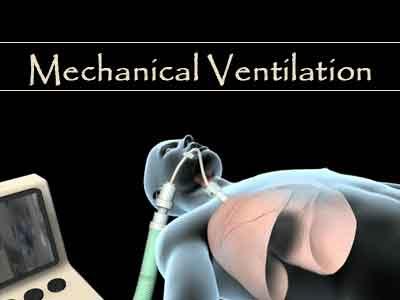- Home
- Editorial
- News
- Practice Guidelines
- Anesthesiology Guidelines
- Cancer Guidelines
- Cardiac Sciences Guidelines
- Critical Care Guidelines
- Dentistry Guidelines
- Dermatology Guidelines
- Diabetes and Endo Guidelines
- Diagnostics Guidelines
- ENT Guidelines
- Featured Practice Guidelines
- Gastroenterology Guidelines
- Geriatrics Guidelines
- Medicine Guidelines
- Nephrology Guidelines
- Neurosciences Guidelines
- Obs and Gynae Guidelines
- Ophthalmology Guidelines
- Orthopaedics Guidelines
- Paediatrics Guidelines
- Psychiatry Guidelines
- Pulmonology Guidelines
- Radiology Guidelines
- Surgery Guidelines
- Urology Guidelines
New guidelines for discontinuing mechanical ventilation in ICU

The American College of Chest Physicians (CHEST) and the American Thoracic Society (ATS) have published new guidelines for discontinuing mechanical ventilation in critically ill adults. The goal of the guidelines is to help physicians and other health care professionals determine when patients with acute respiratory failure can breathe on their own and to provide clinical advice that may increase the chances for successful extubation.
Mechanical ventilation is a life saver, and studies have shown that at any particular moment about 40 percent of all patients in the intensive care unit are breathing with the help of a mechanical ventilator. However, mechanical ventilation can lead to complications, including infections and injury to the lungs and other organs.
Reducing the length of time patients are on mechanical ventilation decreases the risk of these complications, but premature removal from mechanical ventilation can produce other complications and increase mortality.
"Our guidelines committee wished to update the 2001 CHEST guideline concerning ventilator liberation, but we wished to do so by addressing new clinical questions. Our goal was to translate the latest findings into guidelines to improve patient care." said co-lead author and associate professor of medicine at Henry Ford Hospital in Detroit Daniel R. Ouellette, MD, FCCP. "These latest guidelines are informed by many studies published in the last 10 to 15 years that look at other factors that critical care clinicians control that affect a patient's ability to be liberated from the ventilator in a timely manner."
Based on a systematic review of medical studies, the committee's recommendations for acutely hospitalized adults on mechanical ventilation for more than 24 hours are:
• For patients at high risk for extubation failure who have passed a spontaneous breathing trial (SBT), we recommend extubation to preventative non-invasive ventilation (NIV). The committee found evidence that transitioning to non-invasive ventilation reduced ICU length of stay and short- and long-term mortality. The authors emphasized that in these patients NIV should begin immediately after extubation "to realize the outcome benefits."
• We suggest that the initial SBT be conducted with inspiratory pressure augmentation rather than T-piece or CPAP. The committee wrote that conducting the initial SBT with pressure augmentation was more likely to be successful, produced a higher rate of extubation success and was associated with a trend towards lower ICU mortality.
• We suggest protocols attempting to minimize sedation. The committee found that sedation protocols reduced ICU length of stay. However, the protocols did not appear to decrease time on the ventilator or reduce short-term mortality. The authors could not recommend one protocol over another but said the burden of providing sedation by any of the protocols was "very low."
• We suggest protocolized rehabilitation directed toward early mobilization. The committee wrote that patients receiving the intervention spent less time on the ventilator and were more likely to be able to walk when they left the hospital. However, their mortality rate appeared unchanged. The authors noted the exercises created additional work for ICU staff that might have come at the expense of other care priorities.
• We suggest managing patients with a ventilator liberation protocol. The committee said that patients managed by protocol spent on average 25 fewer hours on mechanical ventilation and were discharged from the ICU a day early. However, their mortality rate appeared unchanged.
• We suggest performing a cuff leak test in patients who meet extubation criteria and are deemed at high risk for post-extubation stridor. The committee suggested that the test should be used only in patients with a high risk of stridor (abnormal breathing caused by blockage of windpipe) after extubation. Although patients passing the test had lower stridor and reintubation rates, the authors wrote that a high percentage of patients who failed the test could be successfully extubated.
• For patients who failed the cuff leak test but are otherwise ready for extubation, we suggest administering systemic steroids at least 4 hours before extubation. The committee said that clinical judgment should take priority over test results, and systemic steroids should be administered to these patients at least 4 hours before extubation. The authors added that the short duration of the steroid therapy was likely to improve success rates without resulting in adverse events.
Timothy Girard, MD, co-lead author of the guidelines and an associate professor of medicine at the University of Pittsburgh, said the committee hoped the guidelines would help reduce variations in practice that do not benefit patients. "We are not prescribing a specific approach to care for every patient every time," he said. "But we are trying to summarize the available evidence in as clear and succinct a way as possible so that clinicians know how it applies to most patients."
Dr. Girard added that with "almost every question we looked at, in one form or another, there is a need for additional studies."
You can read the full Article by clicking on the following link :
http://www.chestnet.org/Publications/CHEST-Publications/Guidelines-Consensus-Statements

Disclaimer: This site is primarily intended for healthcare professionals. Any content/information on this website does not replace the advice of medical and/or health professionals and should not be construed as medical/diagnostic advice/endorsement or prescription. Use of this site is subject to our terms of use, privacy policy, advertisement policy. © 2020 Minerva Medical Treatment Pvt Ltd